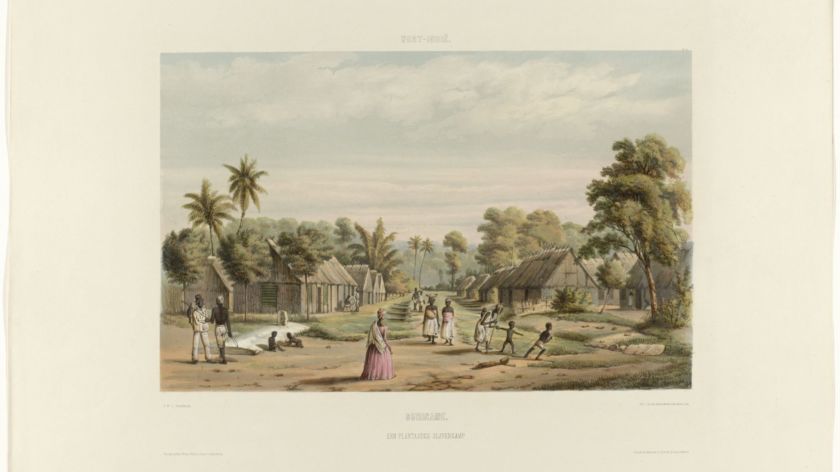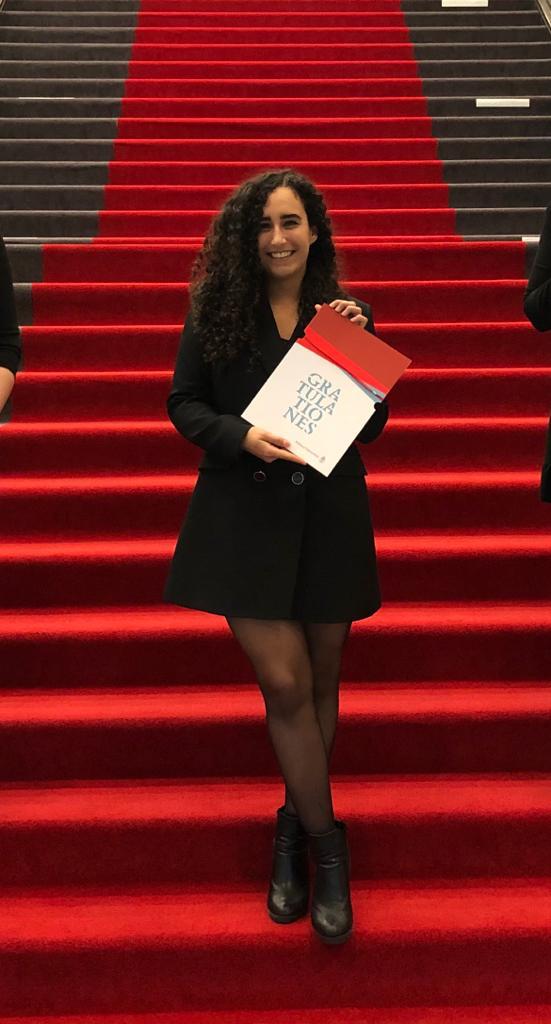Celebrating the end of slavery: ‘For me, Keti Koti is already a national holiday’
-
 Slavenkamp in Suriname, jonkheer Jacob Eduard van Heemskerck van Beest, naar Gerard Voorduin, 1860 - 1862 (via Rijksmuseum)
Slavenkamp in Suriname, jonkheer Jacob Eduard van Heemskerck van Beest, naar Gerard Voorduin, 1860 - 1862 (via Rijksmuseum)
Every year, Keti Koti is celebrated on the 1st of July, the day slavery was abolished in Curaçao and Suriname. Master’s student Denischa de Jezus about the meaning of the celebration, an exhibition in the Erasmus building, Gelderland’s slave history – and why visibility is everything: ‘Keti Koti is a way of showcasing culture and identity.’
If one doesn’t pay attention, the display cases in the entrance of the Erasmus building are, admittedly, easy to miss. But since the 29th of June, visitors hurrying to the elevators are passing an important – and at times controversial – part of Dutch history: the glass boxes contain exhibition pieces of the project “humans as property”, investigating slavery in Curaçao and Suriname during the 19th century.
‘The names that have been crossed out are slaves that have been sold,’ explains Denischa de Jezus while we’re passing the vitrines. De Jezus, who is currently a master’s student at Radboud University, has partaken in the course associated with “humans as property” taught by the project head Coen van Galen. Currently, she is rounding up an internship about slavery in Gelderland at Erfgoed Gelderland. For her, the project is personal.
Slavery in Gelderland
‘I never saw myself as Surinamese. My father’s family migrated from Suriname to the Netherlands when he was a young boy and they assimilated to Dutch culture. The history of Suriname has always been interesting to me, but I never knew much about it.’ Her internship has now changed that – and revealed traces of Suriname’s history in unexpected places.
De Jezus, who grew up in Gelderland, explains that the history of slavery in the Netherlands is mostly associated with the large port cities like Amsterdam, from which the slave trade operated. But even provinces in the far East, such as Gelderland, have not been untouched by slavery: ‘That is exactly what this project is trying to show: the traces of slavery are everywhere and very easy to miss.’
‘The traces of slavery are everywhere and very easy to miss’
One of the most striking moments during her internship has been a visit to kasteel Cannenburch: ‘There was this huge painting of a beautiful white lady in a very pretty dress. But once you take a closer look, you see that she’s not alone in the painting. There is a black boy in the lady’s shadow, barely visible, because she takes so much space. If I would have visited the castle by myself, I would have probably missed him.’
For De Jezus, the invisible history of black people in the shadow of white people has been a recurrent topic during her internship. ‘A lot of wealthy families in Gelderland had slaves. Sometimes, we know their names, like Quaco or Anna, but sometimes, for example with the boy in the painting, we don’t even know that. Our project is about trying to give people, like the boy, their identity back.’ A large part of which is connected not only to how the history of slavery in the Netherlands is told – but also how its end is celebrated.
Keti Koti: Breaking the chains
The name of the annual remembrance day Keti Koti translates to “the chain is broken”, something that quite literally happened on the 1st of July 1863 when slavery was abolished in Curaçao and Suriname. However, for De Jezus, Keti Koti is not only a sad remembrance day: ‘It’s emotional, but most of all it’s a celebration. For me, Keti Koti is about celebrating the freedom of many people that were kept in custody.’
Recently, the Netherlands has been debating whether to make the 1st of July a national holiday. A debate De Jezus doesn’t understand: ‘For me, Keti Koti is already a national holiday. There are so many national holidays that are nothing more but a free day for many people, but Keti Koti is actually celebrated, people know what happened on that day. Making it a national holiday would enable the people who want to take part in it to attend the big celebrations in Amsterdam.’
No-one quite knows the origins of Keti Koti, but especially in Amsterdam, the 1st of July is a colourful celebration of identity. ‘When my father arrived with his family in the Netherlands, it was all about becoming Dutch’, De Jezus explains. ‘Keti Koti is a way of showcasing a culture and identity that has been suppressed for a long time because of slavery.’
For De Jezus, Keti Koti, however, is also about recognition: ‘Slavery existed, you can’t erase this part of your history.’ And whether it is exhibited in the display cases of the Erasmus building, in the shadow of a painting or in the streets of Amsterdam today – if one only looks careful enough, it can be found everywhere.
The exhibition in the Erasmus building runs until September 15th.





Wynand Meyering schreef op 18 september 2022 om 21:43
The Dutch Government needs to establish an international stock market listed, International Investment fund in which the entire population of the Netherlands can invest and save to improve international relations… they can save the share dividends in various currencies.
verschil tussen schreef op 6 december 2022 om 17:05
Excellent article. Very interesting to read. I really love to read such a nice article. Thanks! keep rocking.